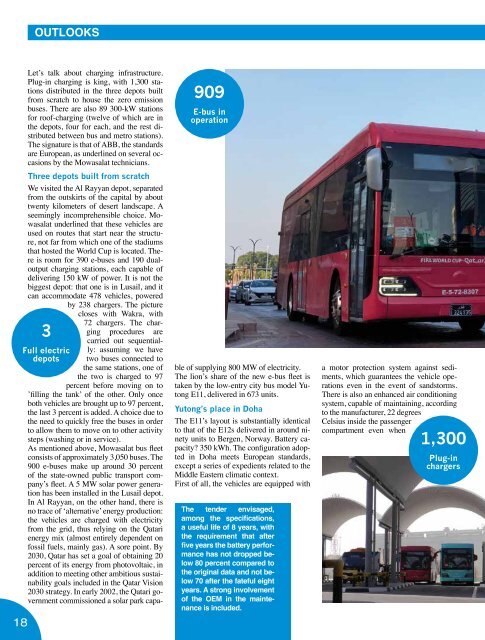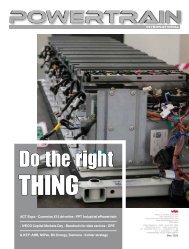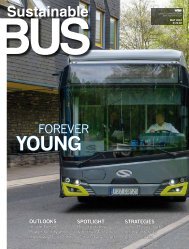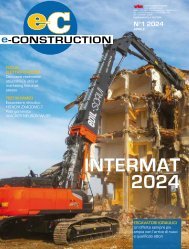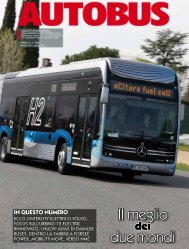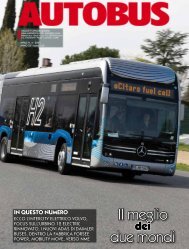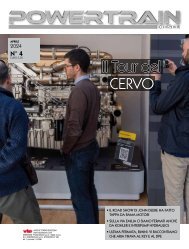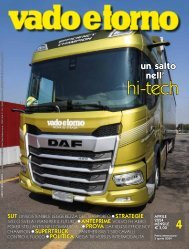SUSTAINABLE BUS 2-2023
Topics? A clear picture of fundings available for zero emission buses in UK, an insight on the fuel cell bus market, a glimpse of the largest electric bus fleet in Middle East (hint: Mowasalat). Again: focus on safety precautions in H2 bus depots, a commentary on the market for second hand e-buses (and battery residual value). Finally: technical presentations of VDL Citea new generation (cover story!), Iveco Bus Crossway LE CNG, Rampini Hydron (and new zero emission bus range)
Topics? A clear picture of fundings available for zero emission buses in UK, an insight on the fuel cell bus market, a glimpse of the largest electric bus fleet in Middle East (hint: Mowasalat). Again: focus on safety precautions in H2 bus depots, a commentary on the market for second hand e-buses (and battery residual value).
Finally: technical presentations of VDL Citea new generation (cover story!), Iveco Bus Crossway LE CNG, Rampini Hydron (and new zero emission bus range)
You also want an ePaper? Increase the reach of your titles
YUMPU automatically turns print PDFs into web optimized ePapers that Google loves.
OUTLOOKS<br />
18<br />
Let’s talk about charging infrastructure.<br />
Plug-in charging is king, with 1,300 stations<br />
distributed in the three depots built<br />
from scratch to house the zero emission<br />
buses. There are also 89 300-kW stations<br />
for roof-charging (twelve of which are in<br />
the depots, four for each, and the rest distributed<br />
between bus and metro stations).<br />
The signature is that of ABB, the standards<br />
are European, as underlined on several occasions<br />
by the Mowasalat technicians.<br />
3<br />
Full electric<br />
depots<br />
Three depots built from scratch<br />
We visited the Al Rayyan depot, separated<br />
from the outskirts of the capital by about<br />
twenty kilometers of desert landscape. A<br />
seemingly incomprehensible choice. Mowasalat<br />
underlined that these vehicles are<br />
used on routes that start near the structure,<br />
not far from which one of the stadiums<br />
that hosted the World Cup is located. There<br />
is room for 390 e-buses and 190 dualoutput<br />
charging stations, each capable of<br />
delivering 150 kW of power. It is not the<br />
biggest depot: that one is in Lusail, and it<br />
can accommodate 478 vehicles, powered<br />
by 238 chargers. The picture<br />
closes with Wakra, with<br />
72 chargers. The charging<br />
procedures are<br />
carried out sequentially:<br />
assuming we have<br />
two buses connected to<br />
the same stations, one of<br />
the two is charged to 97<br />
percent before moving on to<br />
’filling the tank’ of the other. Only once<br />
both vehicles are brought up to 97 percent,<br />
the last 3 percent is added. A choice due to<br />
the need to quickly free the buses in order<br />
to allow them to move on to other activity<br />
steps (washing or in service).<br />
As mentioned above, Mowasalat bus fleet<br />
consists of approximately 3,050 buses. The<br />
900 e-buses make up around 30 percent<br />
of the state-owned public transport company’s<br />
fleet. A 5 MW solar power generation<br />
has been installed in the Lusail depot.<br />
In Al Rayyan, on the other hand, there is<br />
no trace of ‘alternative’ energy production:<br />
the vehicles are charged with electricity<br />
from the grid, thus relying on the Qatari<br />
energy mix (almost entirely dependent on<br />
fossil fuels, mainly gas). A sore point. By<br />
2030, Qatar has set a goal of obtaining 20<br />
percent of its energy from photovoltaic, in<br />
addition to meeting other ambitious sustainability<br />
goals included in the Qatar Vision<br />
2030 strategy. In early 2002, the Qatari government<br />
commissioned a solar park capa-<br />
909<br />
E-bus in<br />
operation<br />
ble of supplying 800 MW of electricity.<br />
The lion’s share of the new e-bus fleet is<br />
taken by the low-entry city bus model Yutong<br />
E11, delivered in 673 units.<br />
Yutong’s place in Doha<br />
The E11’s layout is substantially identical<br />
to that of the E12s delivered in around ninety<br />
units to Bergen, Norway. Battery capacity?<br />
350 kWh. The configuration adopted<br />
in Doha meets European standards,<br />
except a series of expedients related to the<br />
Middle Eastern climatic context.<br />
First of all, the vehicles are equipped with<br />
The tender envisaged,<br />
among the specifications,<br />
a useful life of 8 years, with<br />
the requirement that after<br />
five years the battery performance<br />
has not dropped below<br />
80 percent compared to<br />
the original data and not below<br />
70 after the fateful eight<br />
years. A strong involvement<br />
of the OEM in the maintenance<br />
is included.<br />
a motor protection system against sediments,<br />
which guarantees the vehicle operations<br />
even in the event of sandstorms.<br />
There is also an enhanced air conditioning<br />
system, capable of maintaining, according<br />
to the manufacturer, 22 degrees<br />
Celsius inside the passenger<br />
compartment even when<br />
1,300<br />
Plug-in<br />
chargers<br />
the temperature outside reaches 50 degrees.<br />
There is space on board for up to 72<br />
people, 32 of whom are seated.<br />
Not only city buses...<br />
In addition to the E11, 60 electric minibuses<br />
and midibuses (E7 and E9) and 60<br />
electric Class III e-buses are also in ope-<br />
The 900 e-buses make up<br />
around 30 percent of the<br />
state-owned public transport<br />
company’s fleet. A 5<br />
MW solar power generation<br />
has been installed in the<br />
Lusail depot. In Al Rayyan,<br />
on the other hand, there<br />
is no trace of ‘alternative’<br />
energy production: the<br />
vehicles are charged with<br />
electricity from the grid,<br />
thus relying on the Qatari<br />
energy mix (almost entirely<br />
dependent on fossil fuels,<br />
mainly gas). A sore point.<br />
By 2030, Qatar has set a<br />
goal of obtaining 20 percent<br />
of its energy from the sun.<br />
Qatari government commissioned<br />
a solar park with<br />
capacity of 800 MW.<br />
ration. The former are used in residential<br />
areas for the first and last mile towards underground<br />
and bus stations, the latter, also<br />
sold in Europe under the name of TCe12,<br />
were used for transferring fans to the stadium<br />
and were intended, after the World<br />
Cup, to intercity routes. The 7-metre boasts<br />
a battery capacity of 163 kWh for 38<br />
passengers that can be accommodated on<br />
board (10 seated), while the 9-metre has<br />
211 kWh available for a capacity of 52<br />
passengers (22 seated). The coaches have<br />
an energy storage capacity of 422 kWh<br />
and 51 seats.<br />
The tender envisaged, among the specifications,<br />
a useful life of eight years, with the<br />
requirement that after five years the battery<br />
performance has not dropped below 80<br />
percent compared to the original data and<br />
not below 70 after the fateful eight years.<br />
Again as part of the tender requirements,<br />
a strong involvement of the manufacturer<br />
in the management and maintenance of the<br />
vehicles is included: the processes are carried<br />
out in the Mowasalat plants with the<br />
help of Yutong operators, over a hundred<br />
were present in the country for the period<br />
embraced by the World Cup.<br />
About forty of these are destined to remain<br />
in the area even after the sporting event<br />
has ended (during which it<br />
was possible to see teams<br />
of Chinese technicians on<br />
duty at the bus stops so<br />
as to be able to intervene<br />
in case of need).<br />
What is the estimate of<br />
the cost per kilometer,<br />
in a country where diesel<br />
costs 50 euro cents per liter?<br />
0,03 €<br />
Price for kWh<br />
in Qatar<br />
Well, the 3 euro cents per kilowatt hour of<br />
electricity give a clear verdict: assuming a<br />
(virtuous) consumption of 1 kWh per kilometer<br />
for the e-buses and three with one liter<br />
for a ICE city bus, the price of one kilometer<br />
of electricity turns out to be a fifth of<br />
a fossil kilometer. The fact that the electric<br />
kilometer, in turn, has fossil origins is another<br />
matter. Elementary, my dear Watson.<br />
19


